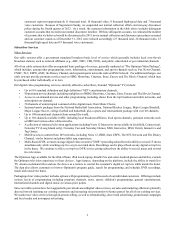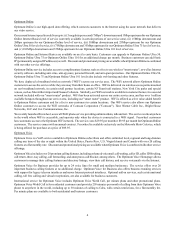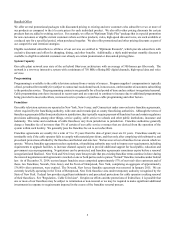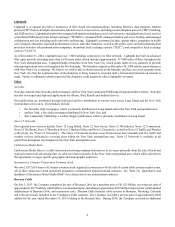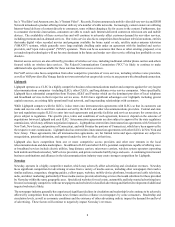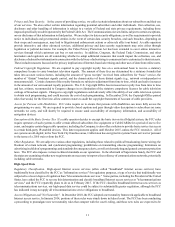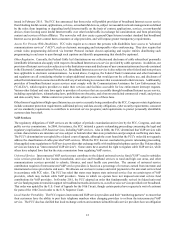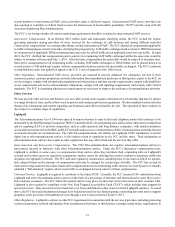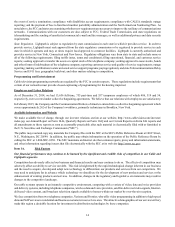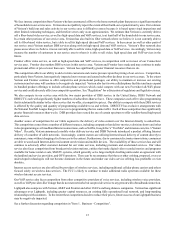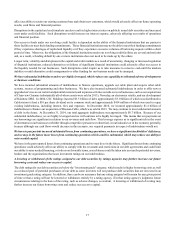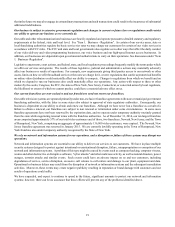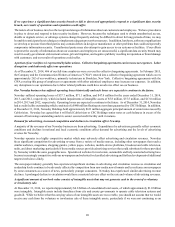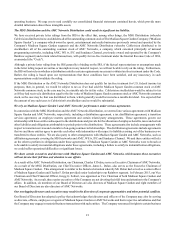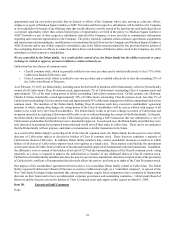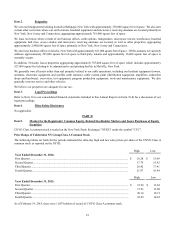Cablevision 2014 Annual Report Download - page 19
Download and view the complete annual report
Please find page 19 of the 2014 Cablevision annual report below. You can navigate through the pages in the report by either clicking on the pages listed below, or by using the keyword search tool below to find specific information within the annual report.13
to port numbers to interconnected VoIP service providers upon a valid port request. Interconnected VoIP service providers are
also required to contribute to federal funds to meet the shared costs of local number portability ("LNP") and the costs of North
American Numbering Plan Administration.
The FCC is reviewing whether all current numbering requirements should be extended to interconnected VoIP services.
Intercarrier Compensation. In an October 2011 reform order and subsequent clarifying orders, the FCC revised the regime
governing payments among providers of voice services for the exchange of calls between and among different networks
("intercarrier compensation") to, among other things, include interconnected VoIP. The FCC addressed compensation applicable
to traffic terminating on carriers' networks, clarifying that prospectively, VoIP traffic exchanged with a carrier in TDM format must
be compensated at applicable TDM terminating interstate rates for all toll traffic and at applicable rates for local traffic. In April
2012, the FCC clarified that compensation paid to carriers for originating VoIP traffic exchanged within the same state would be
subject to intrastate toll rates until July 1, 2014. After that date, compensation for such traffic would be reduced to interstate rates.
Intercarrier compensation for all terminating traffic, including VoIP traffic exchanged in TDM format, will be phased down over
several years to a "bill-and-keep" regime, with no compensation between carriers for most traffic exchanged. The FCC's authority
to establish these rules was upheld on appeal to the U.S. Court of Appeals for the 10th Circuit.
Other Regulation. Interconnected VoIP service providers are required to provide enhanced 911 emergency services to their
customers; protect customer proprietary network information from unauthorized disclosure to third parties; report to the FCC on
service outages; comply with telemarketing regulations and other privacy and data security requirements; comply with disabilities
access requirements and service discontinuance obligations; comply with call signaling requirements; and comply with CALEA
standards. The FCC is examining whether new requirements are necessary to improve the resiliency of communications networks.
Other Services
We may provide other services and features over our cable system, such as games and interactive advertising, that may be subject
to a range of federal, state, and local laws such as privacy and consumer protection regulations. We also maintain various websites
that provide information and content regarding our businesses and offer merchandise for sale. The operation of these websites is
also subject to a similar range of regulations.
Lightpath
The Telecommunications Act of 1996 was enacted to remove barriers to entry in the local telephone market that continues to be
dominated by the Bell Operating Companies ("BOCs") and other ILECs by preempting state and local laws that restrict competition
and by requiring ILECs to provide competitors, such as cable operators and long distance companies, with nondiscriminatory
access and interconnection to the BOC and ILEC networks and access to certain portions of their communications networks (known
as network elements) at cost-based rates. The 1996 Telecommunications Act entitles our Lightpath CLEC subsidiaries to certain
rights, but as telecommunications carriers, it also subjects them to regulation by the FCC and the states. Their designation as
telecommunications carriers also results in other regulations that may affect them and the services they offer.
Interconnection and Intercarrier Compensation. The 1996 Telecommunications Act requires telecommunications carriers to
interconnect directly or indirectly with other telecommunications carriers. Under the FCC's intercarrier compensation rules,
Lightpath is entitled, in some cases, to compensation from carriers when they terminate their originating calls on Lightpath's
network and in other cases are required to compensate another carrier for utilizing that carrier's network to terminate traffic that
originates on Lightpath’s network. The FCC and state regulatory commissions, including those in the states in which we operate,
have adopted limits on the amounts of compensation that may be charged for certain types of traffic. The FCC has revised its
intercarrier compensation rules to phase intercarrier compensation rates for terminating traffic down over several years to eventually
establish a "bill-and-keep" regime, where most traffic is exchanged between carriers without compensation.
Universal Service. Lightpath is required to contribute to the federal USF. Currently, the FCC assesses USF contributions from
Lightpath and other telecommunications carriers on the basis of a percentage of interstate and international revenue they receive
from end-user customers. The FCC limits the amount carriers may place on universal service line items on their customer bills.
Lightpath is also required to contribute to the New York Targeted Accessibility Fund ("TAF"), which includes state support for
universal service. State universal service funds have not been established in other states in which Lightpath operates. As noted
above, the FCC has made fundamental changes to its federal universal service fund programs, reorienting universal service support
programs to the provision of broadband services through a new Connect America Fund ("CAF").
Other Regulation. Lightpath is subject to other FCC requirements in connection with the services it provides, including protecting
customer proprietary network information from unauthorized disclosure to third parties; meeting certain notice requirements in


